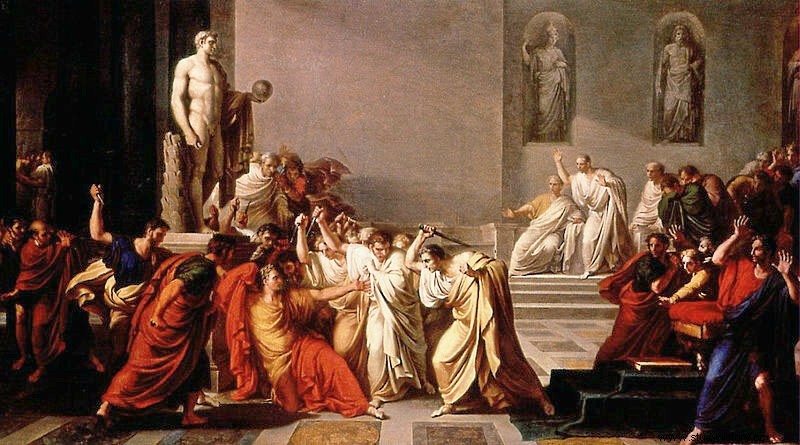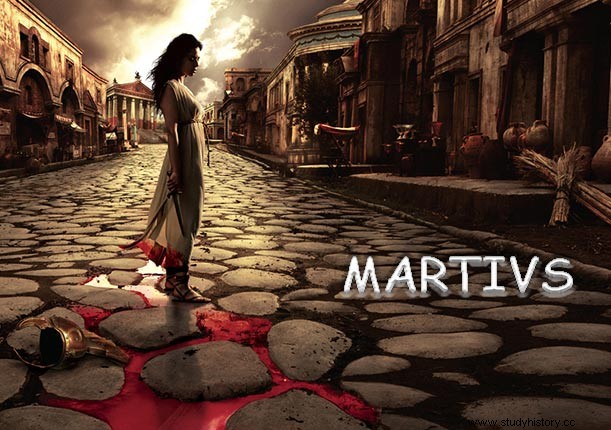MARTIVS was the feminine month of the Roman world, consecrated to the great Mother Goddess, Magna Mater, and was initially the first month of the calendar. The name of the month recalls Mars , Mars , god of vegetation in its origins who ended up embodying the most popular and usual hobby of the Roman Senate:war. The god was depicted armed as a Greek hoplite and his sacred animal was the wolf.
It was a very lively month; In it, public office began, the republican elections took place and, after them, the consequent consulates began.
In the Kalendas of Martius the Matronalia was celebrated . It was the festival of married women, matrons. Husbands entertained their wives with banquets and gifts. Even the great poet Publio Ovidio Nasón , who lived in the times of the austere Augustus, reconsidered some female parties in the month consecrated to Mars... But everything has an explanation:After the kidnapping of the Sabine women, a war broke out between Rome and its neighbors. This war ended this first day of Martius and, precisely, the end of hostilities was orchestrated by the women of both sides. The festival was dedicated to the goddess Juno Lucina , "the one who goes to the light", protective divinity of the births. She hadn't been pregnant in the whole city without going to her temple that day to offer her some ex-voto.
To commemorate the end of the Mare Clausum – the winter closure of maritime trade routes – on the 5th the Ship of Isis was celebrated . The priests marched in procession towards the port and there a ship loaded with offerings was launched. The goddess Isis Coming from Egypt, she made a deep impression as an import divinity in imperial Rome. There are many images of Isis nursing the infant Horus, an image that at first glance recalls early medieval Marian imagery. The deep devotion of many Roman women to this Egyptian goddess paved the way for the later cult of the mother of Christ.
On the eve of the Ides of Martius, an immortal date for reasons unrelated to Roman religion that I will explain later, the Mamuralia was celebrated. , the feast of old Mars, Mamurius Veturius; This celebration consisted of an old man dressed in skins being pushed out of the city with clubs. The clubs were long and white and the old man in question personified winter. It was a rite to expel the cold and welcome spring (remember that Mars in the remote times of the monarchy was the god of vegetation)
The Ides of Martius from 44 B.C. They have gone down in history for being the date of the political assassination of Caesar on the steps of Pompey's Theatre, on that date the meeting place and debate of the Senate. The Italian archaeologist and writer Valerio Máximo Manfredi he published a new novel with this name in which he recreates the last days of the dictator and the republican conspiracy that ended his life and his excessive ambition.

On the 17th of Martius the Liberalia took place , also known as the Great Dionysiacs or Bacchanals . Liberty He was the god of fertility and the original wine of the Roman people who gradually changed to Bacchus at the end of the Republic. In principle, the Liberalia was constituted as an exclusive festivity for women, but over the years its rites were also opened to the male population. The state always viewed these festivals with suspicion and they were banned on several occasions due to the possibility of hiding conspiracies.
Despite this, the Bacchanals were so popular that they could not be eradicated until the Church denounced them as impious and lacking. of morale and were harshly persecuted. It is a topic. They were not as shameless as we can imagine, but the new ideological tendencies of the State collided with liberalism (Where does the etymology of the word liberal come from? ) of pagan festivals. With the imposition of the Christian faith on the ancient cults, the Roman cliché of endless wine orgies and sex died.
March 19 was the festival of artisans, the Quincuatros . It is curious that this date corresponds to the current San José, patron saint of carpenters. The midwives cooked that day and on the first day of the festival there was a gladiator fight in the amphitheatres, just as there is now a bullfight. Another intelligent adaptation of the Church to deep-rooted customs that it did not want to confront and that it was easier to rename. In Valencia this day we continue gathering old wood and lighting bonfires in honor of Minerva; Now they are called Fallas .
On the 22nd of Martius the Cibeles festivities began , Mother Earth, an imported divinity from Phrygia, in central Anatolia, who was also absorbed by the immense Roman pantheon. That same day violets were brought to the deceased, a rite known as Violaria.
On the 24th the priests of Cibeles voluntarily castrated themselves as Attis did. spilling his blood consecrated to the goddess. That night the resurrection of this god was celebrated, the legendary eunuch lover of Cibeles and faithful driver of his chariot of lions. Here we have the first cult of a resurrection, another popular concept very well used years later...
The next day there was a colorful procession that toured the city in the direction of the Cibeles temple, today under the Basilica of Saint Peter on the Hill Vatican.
The Cibeles festivities culminated on the 27th with a solemn procession in which an effigy of the goddess made of silver was paraded through the streets of Rome to the river Almo. The high priest, dressed in purple, bathed the goddess and performed a rite to favor the rain and the fertility of the fields.

Collaboration of Gabriel Castelló author of Bravery
